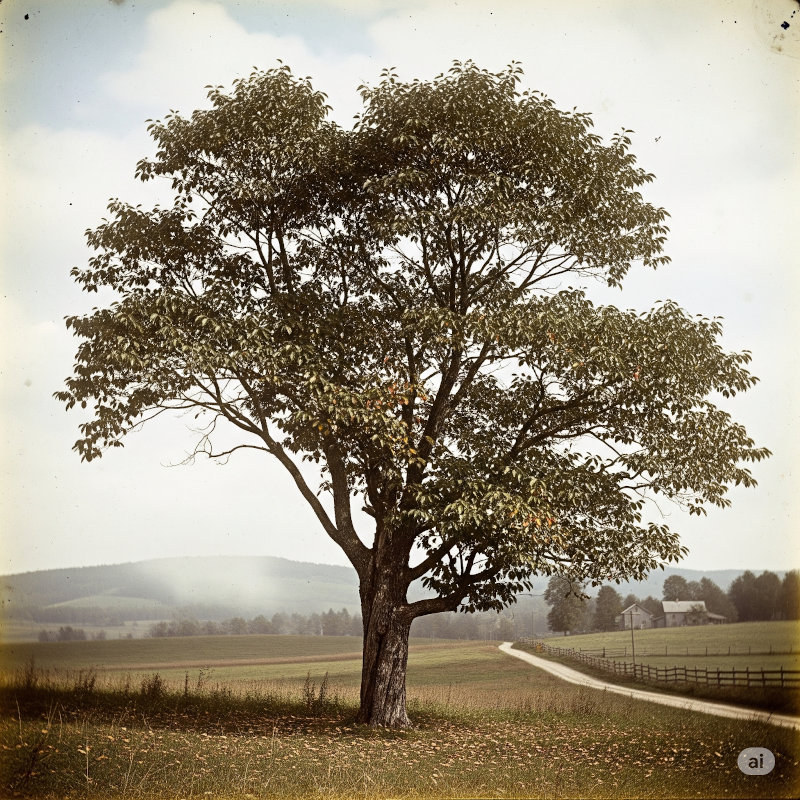Black Cherry (Prunus serotina) in New York, 1870–1900

Scope: A study of black cherry’s ecology, market role, crafting qualities, and how it fit into the late-19th-century New York timber economy before chain saws.
I. Overview & Regional Presence
Black cherry was widespread across the Hudson Valley, Finger Lakes, Southern Tier, and mixed uplands of New York. It often colonized disturbed ground and old fields, eventually becoming a valuable component of mixed hardwood stands. By the late 1800s it was recognized as one of the most desirable native cabinet woods available regionally, particularly prized for furniture and veneers where reachable by mill or road.
II. Wood Properties (Craftsman Perspective)
- Appearance: Warm reddish to brown heartwood with a fine, even grain and attractive luster; darkens with age and finish.
- Workability: Machines and planes well; glues and stains predictably; takes polish to a rich sheen.
- Strength & Durability: Good bending strength and moderate hardness; less decay-resistant than oak or chestnut when exposed to ground contact.
III. Typical Uses (1870–1900)
| Application | Why Black Cherry? | Notes |
|---|---|---|
| Fine furniture & cabinetry | Beautiful finish and color; carves well | Often reserved for higher-end case goods |
| Veneers & paneling | Produces attractive veneers | Used in parlors and showrooms |
| Interior trim & doors | Warm tone, stable when dried | Preferred in houses of modest to fine finish |
| Turned items & small goods | Holds fine detail | Used for knobs, spindles, musical instrument parts |
IV. Markets, Harvesting & Milling
- Selectivity: Black cherry was typically high-graded—millmen sought clear, knot-free logs for veneer and cabinet stock.
- Harvesting: Fell with axe & crosscut; larger, clear logs skidded to landings in winter; shorter logs used locally for smaller stock.
- Milling & Drying: Veneer and fine furniture stock required careful sawing, stickered air-drying, and often longer seasoning than common framing woods.
- Market Pathways: Local cabinetmakers and urban furniture shops drew premium cherry from county mill towns; where transport cost was high, cherry sometimes remained for local higher-end use only.
V. Age, Growth & Board Quality
Merchantable black cherry used for furniture usually came from mature trees—often 80–150 years old depending on site—yielding tight, even grain and deep heartwood color. Faster juvenile growth produced lighter, paler sapwood and narrower heartwood; the best veneer typically came from older, slow-grown stems with consistent grain and sizable clear sections.
VI. Silvicultural & Ecological Notes
- Thrives as a mid-successional species—colonizes openings and old fields, often increasing after disturbance.
- Stands containing cherry were patchy in quality: one hillside might supply excellent veneer logs while the next offered only small, knotty stems.
- Wildlife value: cherry mast (fruit) fed birds and mammals and aided in seed dispersal, linking timber value to ecological functions.
VII. Field Identification in Historic Buildings
Interior trim and casework with warm red tones, tight straight grain, and a fine lustrous surface are good candidates for period black cherry. Early varnish and shellac deepen the wood’s tone; where original finishes survive, they often indicate cherry rather than lighter maples or birch.
Preservation & Repair Tip
When repairing historic cherry, match color and grain: newly cut cherry can be lighter—age and finish darken it. For visible veneer repair, source furniture-grade stock or high-quality modern veneers to match figure and color.
